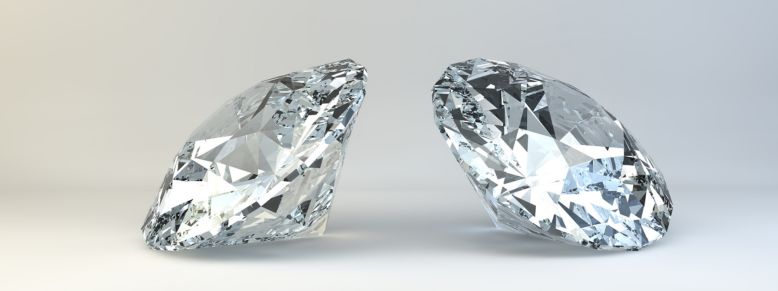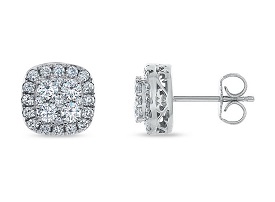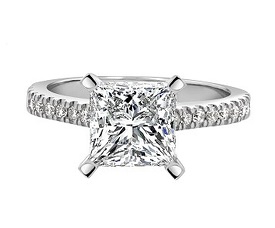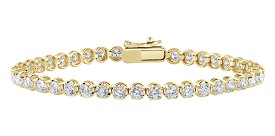March 06, 2024
How to Find High-Quality Lab Grown Diamonds on a Budget
Jennifer Rosser

Lab grown diamonds are indeed real diamonds, possessing the same appearance and quality as mined diamonds, yet they often come at a lower price.
Lab grown diamonds, also called sustainable or cultured diamonds, are produced in controlled laboratory settings through scientific processes. Two common methods used are high-pressure, high-temperature (HPHT), and chemical vapor deposition (CVD).
The primary distinction between lab grown and natural diamonds lies in their origin. Natural diamonds are formed over millions of years beneath the Earth's surface through geological processes, while lab grown diamonds are produced in a matter of weeks or months in laboratories. Despite this difference, both types of diamonds possess the same physical and chemical properties, including hardness, brilliance, and durability.
Understanding the Price Factors in Lab Grown Diamonds
Determining the exact price of a lab grown diamond based on its size can be complex. Several factors influence the price, including carat weight, color, clarity, cut, and market demand.
Quality Check: Low vs. High Grade Diamonds:
- Lower Grade: color with a slight yellow or brown, more visible inclusions, a less precise cut, and a lighter carat weight.
- Higher Grade: top-notch color (D, E, F), fewer visible flaws, precise cut, heavier carat weight.
Cut:
- Well-cut diamonds sparkle more and are worth more.
Clarity:
Clarity refers to the size and number of flaws.
- Flawless diamonds are more expensive; better clarity means a higher price.
Color:
- Colorless diamonds are the most valuable.
- Diamonds with yellow or brown hues are less expensive.
Budget-Friendly Cuts and Shapes: Making Smart Choices
Shape and cut are different aspects when it comes to diamonds. The shape refers to the profile of the diamond, like round, emerald, or heart-shaped. The shape can affect the price, with round diamonds usually being more expensive because they're traditional and popular. Round stones are known for their ability to reflect light well, giving them more sparkle.
Lab grown diamonds online come in various shapes, including round, princess, and cushion cuts. At Rogers & Hollands | Ashcroft & Oak, we provide a range of shapes, helping you find affordable lab grown diamonds that match your style and budget.
Carat size is one of the key components in evaluating diamond pricing. It's not just about weight; it's about how big the diamond looks. A 3-carat diamond will look way bigger than a half-carat one. Prices don't change much for small changes in carat size, but they jump at certain points. Knowing these price jumps at specific carat weights is important for smart budgeting when buying diamonds.
Affordable Lab Grown Diamonds Online
Lab Grown 1ctw. Cushion Diamond Cluster Stud Earrings in 14k White Gold

Our handcrafted, beautiful stud earrings have genuine, white lab grown diamonds totaling 1 carat in weight. They're set in a lovely 14-karat white gold design.
Princess-Cut Lab Grown 1.30ctw. Diamond Hidden Halo Engagement Ring in 14k White Gold

This 14-karat white gold engagement ring includes a 1 carat princess-cut lab grown diamond in the center, with 32 surrounding round lab grown diamonds totaling 0.30 carats.
Lab Grown 8ctw. Diamond 4-Prong Tennis Bracelet in 14k Yellow Gold

Our tennis bracelet is crafted from 14-karat yellow gold and adorned with GH SI lab grown diamonds totaling 8 carats. It measures 7 inches in length.
Budget-Friendly Maintenance: Keeping Your Lab Grown Diamond Sparkling
- Cleaning Techniques
To keep your lab grown diamonds sparkling, use gentle methods. Mix mild soap with lukewarm water in a bowl. Submerge your diamond jewelry and let it soak to loosen dirt. Then, use a soft-bristled brush to gently scrub the diamond and its setting. Pay attention to hidden areas like under the diamond and around the prongs.
- Storage Suggestions
Store your lab grown diamonds separately from other jewelry to prevent scratching. Use soft pouches or fabric-lined jewelry boxes for cushioning. Avoid plastic bags or containers, as they can cause friction and damage the diamond's surface.
- Regular Inspections
Schedule regular inspections with a professional jeweler to check for loose settings or damage. Early detection prevents further issues. Professionals have the tools to detect and resolve problems, so aim for inspections at least once a year.
- Avoiding Damage
Avoid wearing diamond jewelry during activities that could chip or scratch them, like sports. Keep diamonds away from harsh chemicals like chlorine or bleach to prevent discoloration or damage to the metal setting.
- Professional Maintenance
Invest in professional maintenance services like polishing and replating to restore brilliance and address issues. Our professional jewelers at Rogers & Hollands | Ashcroft & Oak can prolong the lifespan of your diamonds and maintain their beauty. Aim for periodic professional maintenance to keep your diamonds looking new.
Final Thoughts
When you're buying our best lab grown diamonds, saving money is all about being smart and informed. Choosing eco-friendly and ethical lab grown diamonds is already a budget-friendly move. Understand what affects diamond prices, do your research, and check out different options. Our jewelry maestros at Rogers & Hollands | Ashcroft & Oak can help guide you to find gorgeous lab grown diamonds online that fit your style and budget.